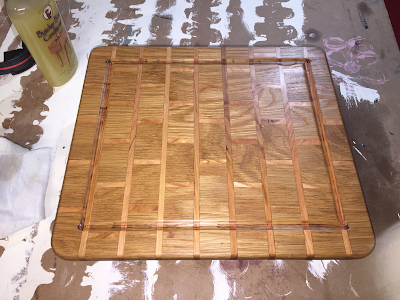Since I "borrowed" most of my Dad's tools to start woodworking, he asks me to make some stuff for him from time to time. Recently he needed some photo shelves made to hang some photos on the wall. The idea is pretty simple, get 3 pieces of trim/moulding and create an L shape that the photos can sit in without sliding off the shelf.
In this picture you can see the 3 pieces of wood that we have. A tall piece for the back with a little detail at the top, a simple flat piece for the bottom and a small piece for the front again with a little detail at the top.
The pieces of wood that I was working with here were slightly warped/bowed so I used glue and nails to hold them together while trying to straighten them out a bit.
I used some 1 1/4 inch nails in the back to nail the pieces together. I started from one side and worked my way across straightening the pieces out as I went along.
I used the same process on the front, glue and nails. I tried to go wider on the spacing with the nails on the front since the piece is smaller and it made for less to fill in after. I used a punch to put the heads of the nails a bit below the surface of the wood. Then I used a bit of wood filler to fill those holes on the front. There is no need to do this on the back since it wont be seen.
I made four shelves all at the same time, which took about 2 hours all together for the assembly, sanding and staining.
My dad wanted something dark like this to go on his wall, I used Minwax Provincial stain.
Here is what they look like mounted on the wall with some photos in them. I think they came out alright and it was definitely cheaper to make these then to buy something similar.



































